Short-Term Residential Yoga Module Development for Bio-Psycho-Social Health Among Adolescents
Astha Choukse1*, Amritanshu Ram2 and H R Nagendra3
1Yoga and Wellness Consultant, S-VYASA Yoga University, India
2Scientist, CAM Program, HCG Enterprise Ltd, India
3The Chancellor, S-VYASA Yoga University, India
Submission: January 07, 2022; Published: January 26, 2022
*Corresponding author: Dr. Astha Choukse, Yoga and Wellness Consultant, S-VYASA Yoga University, India
How to cite this article: Astha Choukse, Amritanshu Ram, H R Nagendra. Short-Term Residential Yoga Module Development for Bio-Psycho-Social Health Among Adolescents. J Yoga & Physio. 2022; 9(4): 555766. DOI:10.19080/JYP.2021.09.555766
Abstract
Background: Adolescent’s health and fitness is often complex phenomenon and dealing with it requires a comprehensive, biopsychosocial approach. Yoga modules as a holistic approach for Adolescent’s overall health, especially in residential setting has not been well researched. Integrated and holistic approach of Yoga is explored in this study to develop a short-term residential yoga module for Bio-psycho-social health among adolescents.
Methods: Concept of five layers of existence (Pancha koshas) (Integrated Approach to Yoga Therapy (IAYT) principles) and literary review was the basis for concepts of adolescents’ biopsychosocial health and integrated yoga module. Focused group discussions (FGD) amongst researchers, experienced yoga gurus, teachers, and psychology experts, were conducted with the objectives of determining needs of the adolescents’ biopsychosocial health and yoga practices that could prove efficient. Feasibility and effectiveness were tested in pre-post study (N=510) conducted in three cohorts in residential setting as yoga camps.
Results: The techniques included in final module based on IAYT was validated by experts. The accumulative results of pre-post study have shown the effectiveness of the yoga module. The correlation between change in variables (δ scores) was explored to understand the relationships between the changes brought about by yoga and interdependence between bio-psycho-social domains.
Conclusion: The developed yoga module is recognized as an effective and accepted short-term residential yoga program for Bio-psycho-social health among adolescents. This study is registered in the Clinical Trials Registry of India bearing the trail number CTRI/2018/02/011709.
Keywords: Yoga Module; Physical; Psychological; Social; Health; Adolescence
Abbreviations: IAYT: Integrated Approach to Yoga Therapy; FGD: Focused group discussions; HYP: Hatha Yoga Pradipika; BG: Bhagavad Gita; SEL: Socio-Emotional Learning; PYS: Patanjali Yoga Sutras
Introduction
Adolescents in general go through distinctive hormonal and biological changes which in turn are associated with psychological changes during puberty [1,2]. These developmental changes are managable but often produce specific behaviour patterns, and unique challenges for individual if not handled satisfactorily. Onset of psychological and psychiatric problems become more prevalent during adolescence, e.g. anxiety, depression, attempted suicide, phobias, mood swing, obesity, bullying, sleeplessness, substance abuse, addiction, engage in risky behavior, attention-deficit disorders etc [3-5]. The situation is serious in several low and middle-income countries [6]. Adolescence is the time for social development, creating a personal identities and sense of autonomy which may sometimes lead to disagreements with their parents, teachers or care givers. Most adolescents deal this satisfactorily and enjoy positive relationships with their families and friends. Adolescents are highly vulnerable to social risks such as experimentation and risk-taking, negative peer pressure, issues related to their bodies and sexuality. George Engel, an American psychiatrist introduced the bio-psycho-social model (BPS model) of overall health [7] in modern psychology. Adolescent’s bio-psycho-social health and fitness is often a complex phenomenon and requires a comprehensive, holistic approach. Early investment in the overall health of adolescents would bring ultimate future benefits in health, finance and social facets [8,9].
Considering the importance of physical, psychological and social health, researchers and clinicians have prescribed a variety of intervention programs for adolescents as helpful measures. Studies have shown that multidisciplinary interventions are essential to tackle health issues of adolescents [6,10] Adapting emotional and social skills during adolescence helps in handling lifestyle, attitude, anxiety, violence, bullying, conflict, anger, and so on [11,12]. Socio-Emotional Learning (SEL) interventions are studied for promoting emotional abilities among youths [13]. Recent years studies have reported usefulness of yoga in improving physical and mental health [14-16], resilience, mood and self-regulation [9,17] Studies also report positive correlation of yoga with self-concept [18], well-being [19], calming effect [20] in adolescents and reduction in anxiety and depression in high risk adolescents [21]. Yoga, which has been medically recognized as an effective complementary and alternative therapy [20], plays a major role in any holistic approach. Yoga is one of the six systems of Indian Philosophy and a psychophysical spiritual science of holistic living. The yoga way of life encompasses the philosophy of Jnana yoga (path of knowledge), Bhakti yoga (path of devotion), Raja yoga (path of self-discipline and practice) and Karma yoga (path of detached action). Raja Yoga or Patanjali yoga, which is also known as Ashtanga Yoga comprises of 8 limbs called Yama (social conducts), Niyama (individual adherences), Asana (postures), Pranayama (breathing techniques), Pratyahara (control of senses), Dharana (focusing), Dhyana (meditation) and Samadhi (contemplation). Yogic psychology conceives human existence as a multi leveled entity comprising Gross Body (Annamaya Kosha), Energy Body (Pranamaya Kosha), Emotional Body (Manomaya Kosha), Intellectual Body (Vijnanamaya Kosha) and Bliss Body (Anandamaya Kosha). This concept is well defined as Pancha Kosha in Taittiriya Upanishad [22].
Right kind of food, good eating habits, postures and games facilitate the development of the physical body (Physical Sheath - Annamaya Kosha). Breathing exercises (pranayama) and cleansing practices improve the quality of the energetic body (Vital Energy Sheath - Pranamaya Kosha). Study of literature, chanting, meditation, devotional sessions for emotional culture and calming the mind for the development of the psychoemotional body (Mental Sheath - Manomaya Kosha). Activities like lectures, yogic counseling, debates, problem-solving that challenge one’s intellect develop the wisdom body (Intellectual Sheath - Vijnanamaya Kosha). All these activities help to go beyond oneself and give an opportunity to identify with the fact that the natural state of oneself is to exist in Bliss (Blissful Sheath - Anandamaya Kosha), which is a state of silence and wakeful awareness [23]. The evolution from one sheath to the next entails prescribed yogic techniques leading to structural framework for linking the emotions, feelings, intellect, energy levels and value systems. Integrated approach of Yoga Therapy (IAYT) or Integrated approach to Yoga Module (IAYM) targets all these five levels of existence which is a holistic approach to promote health and wellbeing at Physical, Psychological, Social and Spiritual level [24,25]. The Pancha Kosha model bears many similarities to the BPS model as used in present-day health psychology. Both these conceptual frameworks understand the interdependence of physical, emotional, psychological, social and spiritual aspects, and its role in optimizing health [26]. The biopsychosocial approach to yoga revisits the very old Kosha model in Taitairya upnishad (the philosophical basis for yoga) while incorporating the insights of modern psychosomatic research. Also the BPS approach to understand health is complemented by the rich ancient traditional concepts provided by various scriptural texts of yoga [27,28] (Figure 1).
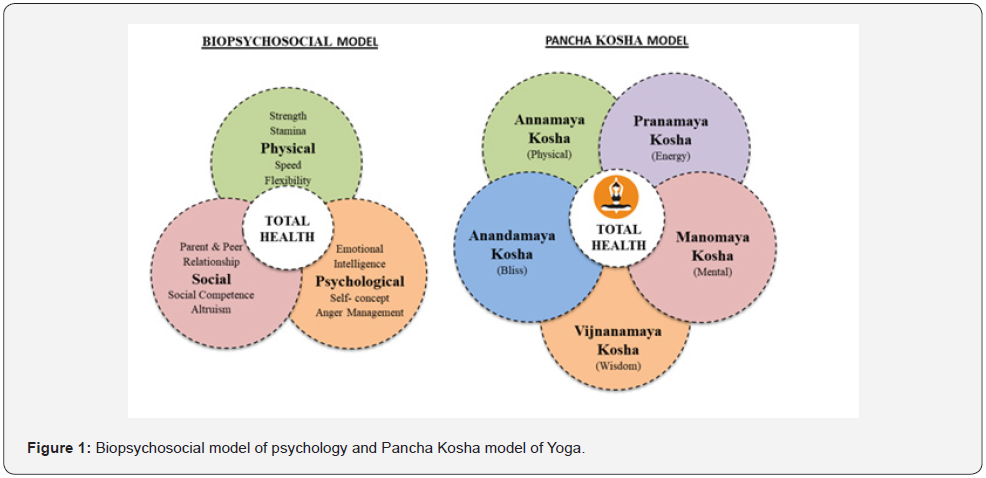
Adding these two concepts, an attempt is made to develop an integrated and holistic residential yoga program for overall health among adolescents. Holistic and integrative approach is established by considering the yogic practices suited to five layers of existence and forms of yoga such as Raja Yoga, Bhakti Yoga, Karma Yoga and Jnana Yoga. Although systematic reviews reported the benefits of yoga programs but available studies suffer from several limitations like inconsistency in intervention type, delivery mechanism, setting, and frequency, small samples, methodology [29,30]. Reviews recommended standardized formats for interventions, robust methodologies, large sampled well-designed and replication studies for firm research evidence base [29,31]. There is a steep increase in research studies on effect of yoga on adolescents and few of yoga modules were also developed for specific problems in adolescents [32,33]. However, to the best of our knowledge, there is no appropriate yoga module developed for overall holistic health of adolescents in residential setting. This study aims at developing an integrated and holistic short-term residential yoga module for Bio-psycho-social health among adolescents.
Material and Methods
The purpose of the study is to develop a yoga module for biopsycho- social health among adolescents. The scope of the study include a) construction of the module based on IAYT principle and literary review, b) validation of the module, and c) assessing the feasibility and effectiveness of the module. d) explore correlations between change in variables to understand the relationships between the changes brought about by yoga. The whole study is planned in phases. It is a residential yoga program designed to provide in school vacations as a residential yoga camp. This study was approved by Institutional Ethics Committee of S-VYASA Yoga University. This study is registered in the Clinical Trials Registry of India bearing the trail number CTRI/2018/02/011709.
Phase 1: FGD to understand need of adolescents’ overall health
First focused Group Discussion (FGD) was organized with a 3-point agenda (a) To understand the concept of health and fitness in adolescents (b) To assess the needs of this transition phase (adolescence) (c) To set the purpose of module. Primary author also solicited the opinion of psychologists, teachers and counsellors. Based on the FGD and experts’ opinion, needs and factors that influence health in adolescents was generated.
Phase 2: Literary review and FGD’s
Literary review: The study relies on scriptural evidence for deriving various techniques and contemporary yoga books for selecting relevant yogic practices. The concepts of overall health and personality are widely embedded in Indian scriptures. Accordingly, Taittiriya Upanishad, Manusmriti, Patanjali Yoga Sutras (PYS), Hatha Yoga Pradipika (HYP) and Bhagavad-Gita (BG) [34-38] were referred to understand the concepts and techniques of biopsychosocial and spiritual health. The concept of Pancha Kosha in Taittiriya Upanishad enumerates the concept of health and fitness at physical, energy, mental, intellectual and bliss level. This formed the basis of classifying health into four categories i.e. Physical, Psychological, Social and spiritual domains. 1) Annamaya Kosha (The Physical Sheath): physical strength, agility, stamina, body awareness, 2) Pranamaya Kosha (The Vital Energy Sheath): Breath Rate, perseverance, discipline, Self-regulation, 3) Manomaya Kosha (The Mental Sheath): Emotions and feelings, a deep relationship between mind, intellect and body, Empathy, 4) Vijnanmaya Kosha (The Intellectual Sheath): Intellect, Will power, guiding factor in man’s actions, motivation, 5) Anandamaya Kosha (The Blissful sheath): Altruism, love and harmony for Spiritual growth results in a feeling of bliss (Ananda) which can be invoked at will. Concept of physical, psychological, social and spiritual health is embedded in the form of duties, rights, laws, conduct, virtues and values in Manusmriti. Practicing yama and niyama concepts, Asana and pranayama practices of PYS will make life disciplined, physically and mentally fit and give physical, mental, social and spiritual strength and stability. Concept of emotional Intelligence in Indian context is embedded in its highly valued morals and virtue practices in BG. The Indian view of emotional Intelligence is context sensitive and focuses on the significant role of guru, parents, family and society. Social skills like respecting elders, helping others, concern for wellbeing of others constitute silent features of EI. Morality of caring and sharing determine emotional responsivity. Few contemporary yoga texts like Yoga Education for Children: volume 1 & 2 [39,40], Integrated approach of yoga therapy for positive health and Krida Yoga [41,42] were also referred.
FGD’s (Focused group discussions): As the need and factors that influence health in adolescents was understood, another string of FGDs were organized with these objectives (1) components of the program (2) which are the yoga practices that could prove efficient under these components (3) which kosha they touch upon (4) how do the efficacy of the module can be assessed (5) what domain of bio-psycho-social health these assessment parameters relate to. Experts who were present with researchers, are Yoga gurus with experience of 30 years, Doctor of Medicine (MD) in Yoga, Doctorates (PhD) in Yoga, and yoga therapists (MSc in yoga), psychologists, schoolteachers. Group came up with different responses which were reviewed and based on that, connections between the elements of intervention, measurements and domains were drawn and the plan of program were laid which is presented in Figure 2.
Phase 3: Designing of module for adolescents’ overall health
After understanding the need of adolescents’ overall health, literary and literature review, FGD’s and expert consultation, the actual designing of the module began keeping pancha kosha concept and IAYT as the basis for the development of this module and laying emphasis on holistic and integrated approach as a base.
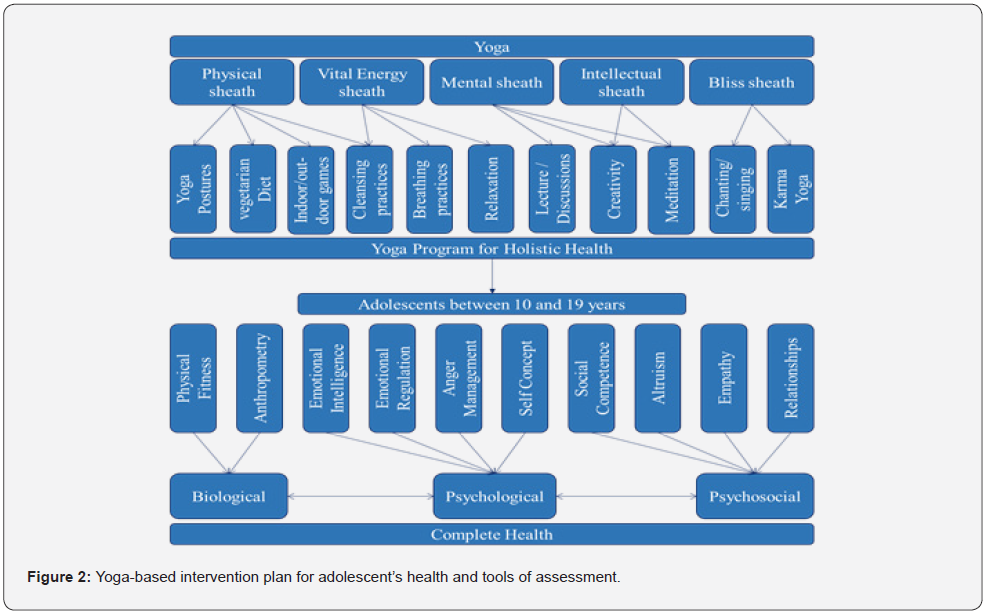
The basic framework for this module development came from the Personality Development Camp conducted by S-VYASA Yoga University during summer vacations every year from last 20 years. The module is designed for a residential setting and for a short duration. This comprised of these major components: Prayers & spiritual singing (Bhakti yoga), warm up practices (Sukshma Vyayama) & physical postures (Asanas), Breathing practices & Pranayama, Relaxation (Vishrama Tantras) & Meditation (Dhyana) (Raja yoga), Lectures & creative activities (Jnana Yoga), Selfless service activities (altruistic group activities - Karma yoga), Games & nature walk (Krida yoga) and Happy assembly (cultural programs).
Since the module is designed for residential setting, activities are spread over throughout the day for all days. A rough framework of activities with time allotment are detailed in the Table 1 and basic plan of study in Figure 2. Specific techniques and their relevance were identified from major streams of Yoga for biopsychosocial and spiritual development in adolescent. Scientific evidence has also been provided for different activities of the module for their relevance and expected benefits which are provided in Table 2.
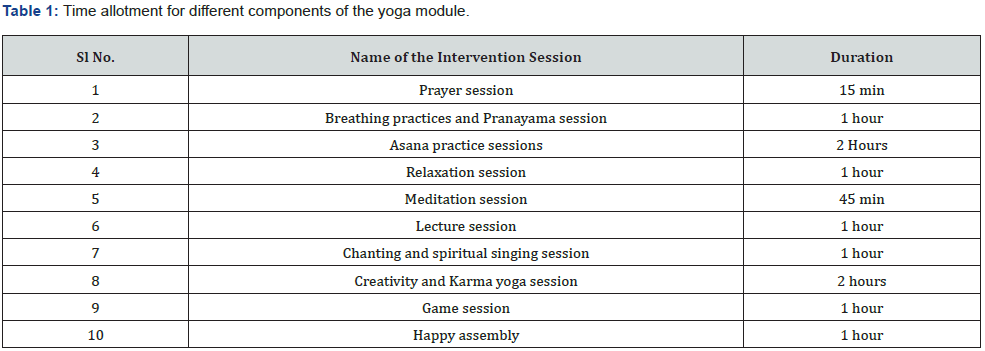
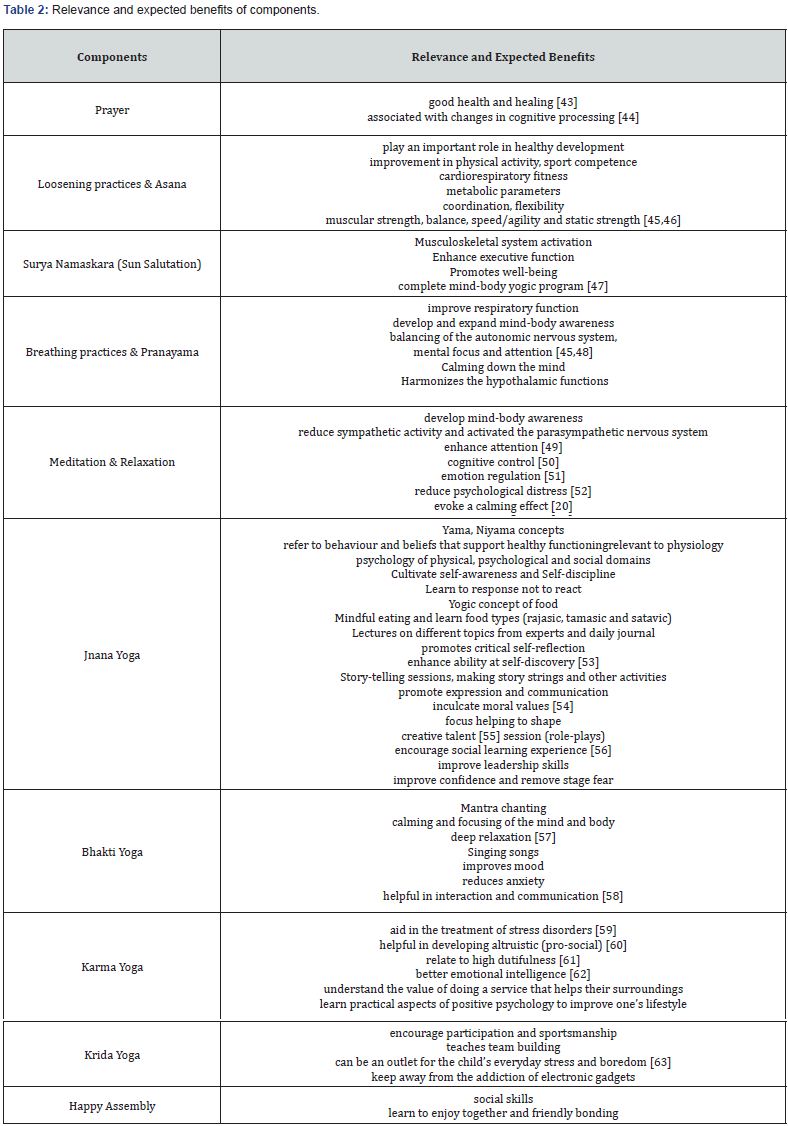
Phase 4: Validation and Field study
This framework of yoga module was prepared considering its ability to implement in the camp settings and presented in FGD for comments and suggestions. A yoga module was constructed using techniques that were qualified in expert validation. This comprised of these major components: Prayers & spiritual singing (Bhakti yoga), warm up practices (Sukshma Vyayama) & physical postures (Asanas), Breathing practices & Pranayama, Relaxation (Vishrama Tantras) & Meditation (Dhyana) (Raja yoga), Lectures & creative activities (Jnana Yoga), Selfless service activities (altruistic group activities - Karma yoga), Games & nature walk (Krida yoga) and Happy assembly (cultural programs). The developed module with all the components and practices is presented in Table 3 and Table 4.
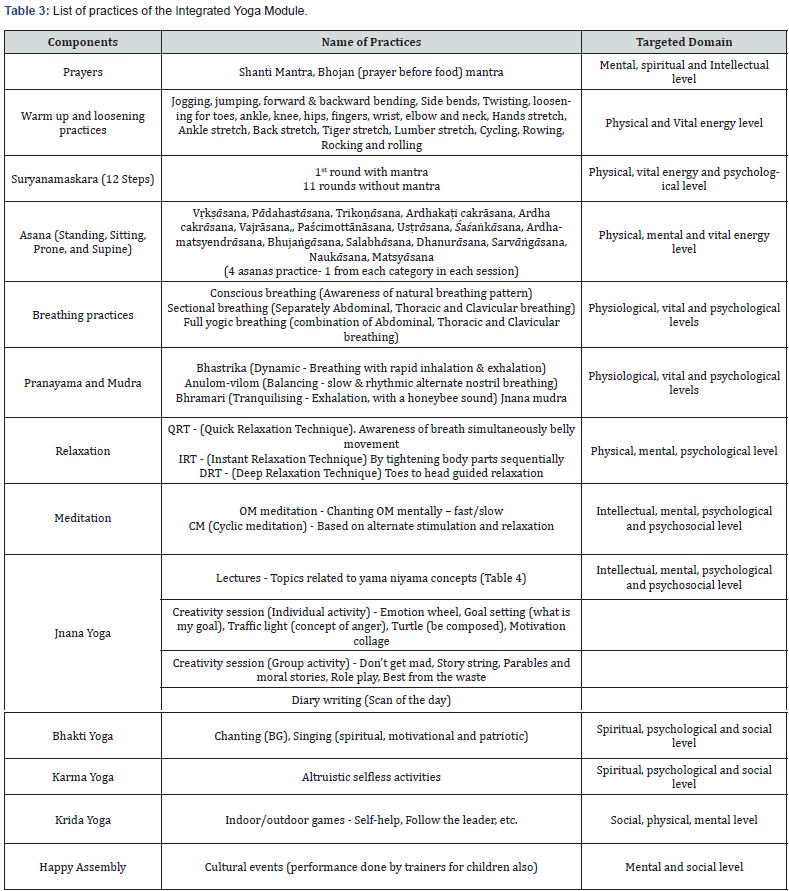

The pre-post study was done in three independent cohorts (batch 1, 2 and 3) of healthy adolescents of both genders (age 9-16 years) (N = 510, 35% girls) in same residential setting (Residential Yoga Camps for adolescents). Parental consents and assents from participants were obtained prior to study. The total duration of the camp is 10 days with 7 full day formal intervention with 1st day for registration and pre data collection and 9th and 10th day for post data collection and valedictory program respectively. To evaluation, a few parameters in Physical, Psychological and Social fitness domains were tested using standardised and validated tools and tests. Details of parameters are given in Table 5.
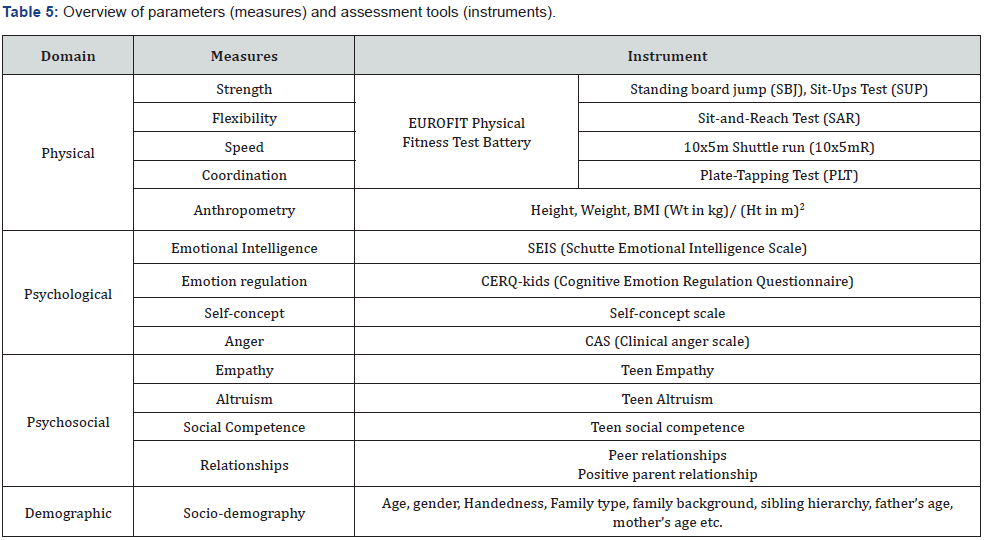
The accumulative pre and post data of study is analyzed using paired t-test to examine the effectiveness of the yoga module. The compiled results confirm the field validation of Integrated Yoga Module for its effectiveness. The results showed reduction in the body weight of participants (-2.52%, p < 0.001) and the BMI (-2.67%, p < 0.001) was also significantly decreased. Besides, there was a significant decrease in time taken (sec) in shuttle run (-0.74%, p = 0.059) and plate tapping (-2.72%, p = 0.008) that showed increase in agility, speed and coordination respectively as reduction in time shows better performance. Likewise, there was significant increase in the board jumping (3.67%, p < 0.001) that showed positive change in strength, significant increase in sit-ups (13.34%, p < 0.001) and sit and reach (3.39%, p < 0.001) showed positive change in muscle endurance and flexibility respectively. Also, SEIS score (3.25%, p < 0.001), CERQ kids (9.29%, p < 0.001), empathy (5.55%, p < 0.001), altruism (4.42%, p < 0.001), social competence (3.11%, p < 0.001) and parent relationship (1.99%, p = 0.020) increased significantly. CAS significance decrease (-15.05%, p < 0.001) showing positive change. Summary of overall changes is provided in Table 6.
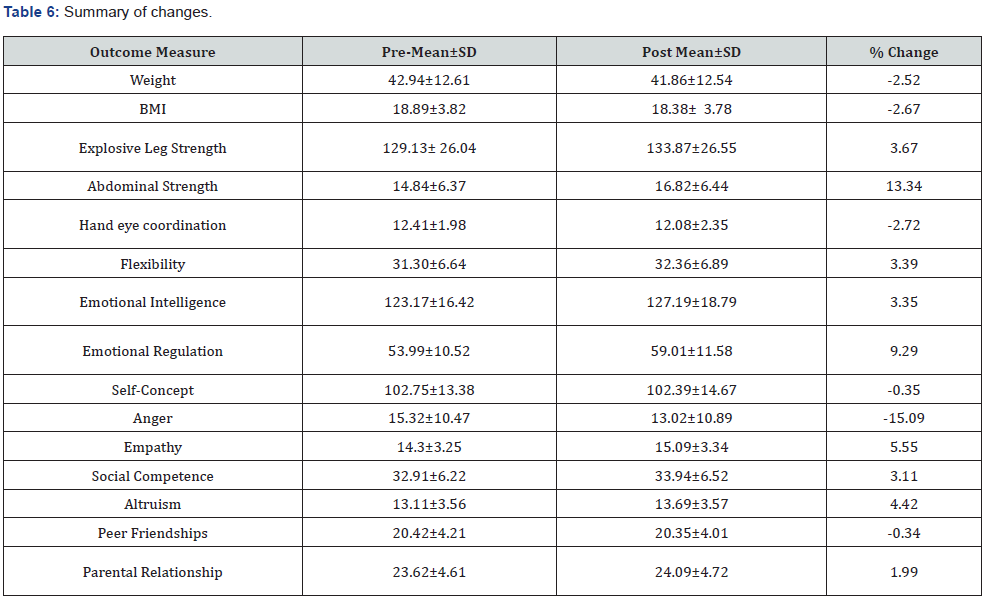
Phase 5: Feedback for Feasibility
Quantitative data could not be collected. But qualitative feedback was taken from parents and participants after the study. Qualitative analysis revealed that participants found the module very interesting and adoptable. The overall participation and positive response of the adolescents establishes the effectiveness of the module. According to parents, this intervention may be a well-accepted option for their kids’ health and personality development as a residential camp in summer holidays. According to parents’ suggestion, time duration of intervention could be more.
Discussion
In this study, an effort was made to develop a comprehensive holistic yoga module based on traditional textual and modern references and expert’s advice for the overall health among adolescents in India. The module was carefully designed to ensure that the prescribed techniques constitute a comprehensive program for overall health of adolescents. To our knowledge, this is the first time a feasible residential yoga module has been developed with specific components addressing each dimension of health. Holisticity was achieved by considering the yogic practices that work at different Koshas. Integrated approach was achieved by emphasizing Yama, Niyama, Asana, Pranayama, Pratyahara, and Meditation as well as considering Bhakti yoga and Jnana Yoga. Experts were involved at all stages of discussion and development of the module. A master list of all components were compiled and presented to the experts and their inputs were collected in focused group discussion (FGD) and taken into consideration. Using a humanized method, rather than a questionnaire scoring method, provided flexibility and a wide scope for the evolution of the concepts. Also rendered a helping hand to researchers as they were allowed to collaborate and gradually develop the module. The development of the modules was done by comprehensive questioning and intense discussion session where one shared their experiences in evolving the steps of the modules.
Relevant aspects of Ashthanga yoga are included in direct or indirect form. Emphasis is given on yama-niyama concepts because inculcation of discipline and moral values are far more important in adolescent and help to make a good transition [64]. The lectures and creative activities were designed keeping in mind the bio-psycho-social health parameters considered in the field study. In the school environment, pressure of studies and competition is so much that students, teachers, and even parents think of academic performance. A residential setting provides a wealth of ways to help children grow and expand their horizons. The experience and intervention, with 24/7 access to experts, is intense and builds meaningful values. A few benefits of children attending a residential yoga camp during the summer break are to learn self-responsibility and independent living; create a disciplined routine to get up, go to bed etc. The main focus to develop a residential module is to provide adolescents a valid chance in holidays to focus and improve their behavioral skills, learn to breathe calmly in every situation; to respond and not to react; to embrace the experience as their own; to show empathy toward others; to extend kindness; form bonds with children from other parts of the country; to understand giving and sharing; to develop a greater sense of responsibility which may further help in reducing childhood stress, anxiety and improve their selfesteem and overall personality. It’s an opportunity for adolescents to learn life skills in a safe, holistic environment beyond the classroom. Practices like spiritual singing (prayers and bhajans Bhakti yoga) releases stress and relaxes the mind. Practices like lectures and counseling (Jnana yoga) help to clear intellectual confusions and conflicts and motivate adolescents to take right decisions in their path. Altruistic activities (Karma yoga) provide sense of selfless work and duty which lead to relaxation and life satisfaction. This yoga module is specifically designed and tested in Residential Setting and not tested for school setting or non-residential setting. But it can be given in school-setting with need-based modification for longer duration. The same could be customized for the specific needs.
It is of extreme importance to provide them multidimensional programs at an early age as a series of research indicate that children with better developed overall fitness have better academic achievement at school [65] and more satisfied and successful emotional and social life [66,67]. Field validation was done by carrying out study using this module. The module was successfully intervened in three cohorts as yoga camps with good sample sizes and provided positive results in physical, psychological and social fitness domains. Comparison of each variable between cohorts in each domain, three month followup, comparison between children and parental data were also established [68,69].
Correlations between change in variables
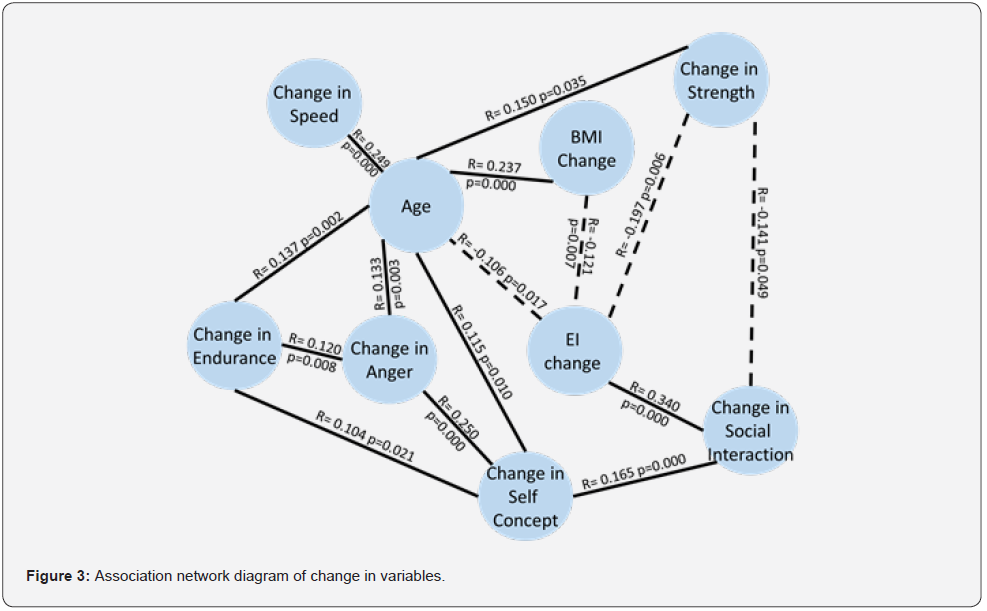
The correlation between change scores (δ scores) was explored to understand the relationships between the changes brought about by yoga and interdependence between bio-psychosocial domains. The age was positively correlated with the change in physical speed, endurance, BMI, strength and temper (anger). The age was negatively correlated with the change in EI. While the change in EI was negatively correlated with the BMI, strength and age but positively correlated to social interaction. Change in self-concept was positively correlated with social interaction, anger, endurance and age. The social interaction was positively related to the change in EI and self-concept but negatively related to strength. However, the change in anger was positively related to endurance, self-concept and age. Significant associations within these variables are represented as an association network diagram in Figure 3.
Spiritual health domain could not be tested due to nonavailability of appropriate scales. The developed yoga module was found to be very well acceptable by adolescents. Subjective feedback from the participants was very good and encouraging. Children enjoyed every activity and had a great learning. This proposed short-term residential yoga module could be introduced as a camp on an annual basis for adolescents during school vacations, the effects of which may be evaluated through the rest of the year.
Conclusion
This study demonstrated that the developed yoga module has good field validity which is designed as per yoga texts and the experience of yoga experts. Successful repeatability with independent cohorts provide strong evidence for validity of holistic yoga module as a powerful tool to establish overall health and fitness among adolescents. Proper integration of multiple components is uniqueness of this wholesome module.
Acknowledgment
The authors acknowledge the support of the University and its faculty for allowing the study to be conducted during the residential summer camp. The authors thank all the participants and parents for their support.
References
- Sawyer SM, Afifi RA, Bearinger LH, Blakemore SJ, Dick B, et al. (2012) Adolescence: A foundation for future health. The Lancet 379(9826): 1630-1640.
- Blakemore SJ, Mills KL (2014) Is Adolescence a Sensitive Period for Sociocultural Processing? Annual Review of Psychology 65(1): 187-207.
- Paus T, Keshavan M, Giedd JN (2010) Why do many psychiatric disorders emerge during adolescence? Nature Reviews Neuroscience 9(12): 947-957.
- Melnyk BM, Jacobson D, Kelly S, Belyea M, Shaibi G, et al. (2013) Promoting Healthy Lifestyles in High School Adolescents: a randomized controlled trial. American Journal of Preventive Medicine 45(4): 407-415.
- Hueston CM, Cryan JF, Nolan YM (2017) Stress and adolescent hippocampal neurogenesis: diet and exercise as cognitive modulators. Translational Psychiatry 7(4): e1081.
- Davidson LL, Grigorenko EL, Boivin MJ, Rapa E, Stein A (2015) A focus on adolescence to reduce neurological, mental health and substance-use disability. Nature 527(7578): S161-S166.
- Engel G (1977) The need for a new medical model: a challenge for biomedicine. Science 196(4286): 129-136.
- Belli PC, Bustreo F, Preker A (2005) Investing in children’s health: what are the economic benefits? Bull World Health Organ 83(10): 777-784.
- Hagen I, Nayar US (2014) Yoga for Children and Young People’s Mental Health and Well-Being: Research Review and Reflections on the Mental Health Potentials of Yoga. Frontiers in Psychiatry 5: 35.
- Jackson SF, Perkins F, Khandor E, Cordwell L, Hamann S, et al. (2006) Integrated health promotion strategies: a contribution to tackling current and future health challenges. Health Promotion International 21(Suppl 1): 75-83.
- Sancassiani F, Pintus E, Holte A, Paulus P, Moro MF, et al. (2015) Enhancing the Emotional and Social Skills of the Youth to Promote their Wellbeing and Positive Development: A Systematic Review of Universal School-based Randomized Controlled Trials. Clinical Practice & Epidemiology in Mental Health 11(1): 21-40.
- Patton GC, Sawyer SM, Santelli JS, Ross DA, Afifi R, et al. (2016) Our future: a Lancet commission on adolescent health and wellbeing. The Lancet 387(10036): 2423-2478.
- Durlak JA, Weissberg RP, Dymnicki AB, Taylor RD, Schellinger KB (2011) The Impact of Enhancing Students’ Social and Emotional Learning: A Meta-Analysis of School-Based Universal Interventions. Child Development 82(1): 405-432.
- Birdee GS, Yeh GY, Wayne PM, Phillips RS, Davis RB, et al. (2009) Clinical Applications of Yoga for the Pediatric Population: A Systematic Review. Academic Pediatrics 9(4): 212-220.
- Greenberg MT, Harris AR (2012) Nurturing Mindfulness in Children and Youth: Current State of Research. Child Development Perspectives 6(2): 161-166.
- Davidson JR, Dunne J, Eccles JS, Engle A, Greenberg M, et al. (2012) Contemplative Practices and Mental Training: Prospects for American Education. Child Development Perspectives 6(2): 146-153.
- Büssing A, Michalsen A, Khalsa SBS, Telles S, Sherman KJ (2012) Effects of Yoga on Mental and Physical Health: A Short Summary of Reviews. Evidence-Based Complementary and Alternative Medicine pp. 1-7.
- Benavides S, Caballero J (2009) Ashtanga yoga for children and adolescents for weight management and psychological well being: An uncontrolled open pilot study. Complementary Therapies in Clinical Practice 15: 110-114.
- Khalsa SBS, Hickey SL, Cohen D, Steiner N, Cope S (2012) Evaluation of the Mental Health Benefits of Yoga in a Secondary School: A Preliminary Randomized Controlled Trial. The Journal of Behavioral Health Services & Research 39(1): 80-90.
- Frank JL, Bose B, Schrobenhauser CA (2014a) Effectiveness of a School-Based Yoga Program on Adolescent Mental Health, Stress Coping Strategies, and Attitudes Toward Violence: Findings from a High-Risk Sample. Journal of Applied School Psychology 30(1): 29-49.
- Frank JL, Bose B, Schrobenhauser CA (2014b) Effectiveness of a School-Based Yoga Program on Adolescent Mental Health, Stress Coping Strategies, and Attitudes Toward Violence: Findings from a High-Risk Sample. Journal of Applied School Psychology 30(1): 29-49.
- Sethumadhavan TN (2011) Taittiriya Upanishad-a brief translation. Esamskriti.com.
- Jagannathan A, Nagarathna R, Ramakrsihna J, Villacres MD (2014a) Decoding the integrated approach to yoga therapy: Qualitative evidence based conceptual framework. International Journal of Yoga 7(1): 22-31.
- Jagannathan A, Nagarathna R, Ramakrsihna J, Villacres MD (2014b) Decoding the integrated approach to yoga therapy: Qualitative evidence based conceptual framework. International Journal of Yoga 7(1): 22-31.
- Nagendra HR (2013) Integrated Yoga Therapy for mental Illness. Indian Journal of Psychiatry 55(3): 337-339.
- Georg F (1998) The yoga tradition: its history, literature, philosophy, and practice. Prescott, Ariz: Hohm Press.
- Cynthia C (2013) Fundamentals of Hand Therapy: Clinical Reasoning and Treatment Guidelines for Common Diagnoses of the Upper Extremity. (Cynthia Cooper, Ed.) (illustrate). Elsevier Health Sciences.
- Matthew JT, Ranay Y, Cooper C (2014) Yoga Therapeutics: A Biopsychosocial Approach. In Cynthia Cooper (Ed.), Fundamentals of Hand Therapy: Clinical Reasoning and Treatment Guidelines for Common Diagnoses of the Upper Extremity (2nd,). Elsevier Health Sciences, pp. 196-205.
- Serwacki ML, Cook CC (2012) Yoga in the schools: a systematic review of the literature. International Journal of Yoga Therapy 22(22): 101-109.
- McCall MC, Ward A, Roberts NW, Heneghan C (2013) Overview of systematic reviews: yoga as a therapeutic intervention for adults with acute and chronic health conditions. Evidence-Based Complementary and Alternative Medicine: ECAM, 945895.
- Burke C (2010) Mindfulness-based approaches with children and adolescents: A preliminary review of current research in an emergent field. Journal of Child and Family Studies 19: 133-144.
- John JM, Navneetham J, Nagendra HR (2017) Development of a Trans-disciplinary Intervention Module for Adolescent Girls on Self-awareness. Journal of Clinical and Diagnostic Research 11(8): VC07-VC10.
- Rathi S, Raghuaram N, Tekur P, Joshi R, Ramarao N (2018) Development and validation of integrated yoga module for obesity in adolescents. International Journal of Yoga 11(3): 231-238.
- Swami S (1921) Taittiriya Upanishad. The Ramakrishna Math, Mylapore, Madras, India.
- Patrick O (2005) Manu’s Code of Law. Oxford University Press, USA.
- Saraswati N (2002) Four Chapters on Freedom: Commentary on the Yoga Sutras of Patanjali.: Yoga Publications Trust, Munger, Bihar, India.
- Swami M (1998) Hatha Yoga Pradipika. Bihar School of Yoga.
- Swami C (1996) The Holy Geeta. Central Chinmaya Mission Trust.
- Swami Satyananda Saraswati (1999) Yoga Education for Children. Yoga Publications Trust 1, Munger, Bihar, India.
- Swami Niranjananada Saraswati (2010) Yoga Education for Children. Yoga Publications Trust, Bihar School of Yoga 2, Munger, Bihar, India.
- Nagendra HR, Nagarathna R (2008) Integrated Approach of Yoga Therapy for Positive Health. Swami Vivekananda Yoga Prakashana, Bangalore, India.
- Svyasa (2009) Krida Yoga. Vivekananda Kendra Prakashan Trust.
- Luhrmann TM (2013) Making God real and making God good: Some mechanisms through which prayer may contribute to healing. Transcultural Psychiatry 50(5): 707-725.
- Luhrmann TM, Nusbaum H, Thiste R (2013) Lord, teach us to pray: Prayer practice affects cognitive processing. Journal of Cognition & Culture 13(1-2): 159-177.
- Felver JC, Butzer B, Olson KJ, Smith IM, Khalsa SBS (2015) Yoga in Public School Improves Adolescent Mood and Affect. Contemporary School Psychology 19(3): 184-192.
- Seo DY, Lee S, Figueroa A, Kim HK, Baek YH, et al. (2012) Yoga Training Improves Metabolic Parameters in Obese Boys. The Korean Journal of Physiology & Pharmacology 16(3): 175-180.
- Bhutkar MV, Bhutkar PM, Taware GB, Surdi AD (2011) How effective is sun salutation in improving muscle strength, general body endurance and body composition? Asian Journal of Sports Medicine 2(4): 259-266.
- Kaley ILC, Peterson J, Fischer C, Peterson E (2010) Yoga as a complementary therapy for children and adolescents: a guide for clinicians. Psychiatry (Edgmont (Pa : Township)) 7(8): 20-32.
- Van de Weijer BE, Formsma AR, De Bruin EI, Bögels SM (2012) The Effectiveness of Mindfulness Training on Behavioral Problems and Attentional Functioning in Adolescents with ADHD. Journal of Child and Family Studies 21(5): 775-787.
- Moore A, Malinowski P (2009) Meditation, mindfulness and cognitive flexibility. Consciousness and Cognition 18(1): 176-186.
- Tang YY, Yang L, Leve LD, Harold GT (2012) Improving Executive Function and Its Neurobiological Mechanisms Through a Mindfulness-Based Intervention: Advances Within the Field of Developmental Neuroscience. Child Development Perspectives 6(4): 361-366.
- Robins C, Keng SL, Ekblad A, Brantley J (2012) Effects of mindfulness-based stress reduction on emotional experience and expression: A randomized controlled trial. Journal of Clinical Psychology 68(1): 117-131.
- Hiemstra R (2001) Uses and benefits of journal writing. New Directions for Adult and Continuing Education 90: 19.
- Chandel R, Arora M (2019) Effect of a Story based Intervention over the Personality of Adolescents (Juvenile Delinquents). International Journal of Education (IJE) 2(01): 1-26.
- Hartzell SA, Hong E (2016) Exploring the Relationship between Adolescent Activities and Choice of Graduate School Discipline: Implications for Creativity Development. Journal of Creative Behavior 50(2): 109-131.
- Russell C, Shepherd J (2010) Online role-play environments for higher education. British Journal of Educational Technology, 41(6): 992-1002.
- Tomasino B, Fregona S, Skrap M, Fabbro F (2012) Meditation-related activations are modulated by the practices needed to obtain it and by the expertise: an ALE meta-analysis study. Frontiers in Human Neuroscience 6: 346.
- Preyde M, Berends A, Parehk S, Heintzman J (2017) Adolescents’ Evaluation of Music Therapy in an Inpatient Psychiatric Unit: A Quality Improvement Project. Music Therapy Perspectives 35(1): 58-62.
- Kumar A, Kumar S (2013) Karma yoga: A path towards work in positive psychology. Indian Journal of Psychiatry 55(2): 150-152.
- Mulla ZR, Krishnan VR (2008) Karma-Yoga, the Indian Work Ideal, and its Relationship with Empathy. Psychology and Developing Societies 20(1): 27-49.
- Mulla ZR, Krishnan VR (2006) Karma Yoga: A Conceptualization and Validation of the Indian Philosophy. Journal of Indian Psychology 24(1,2).
- Mulla ZR, Krishnan VR (2007) Karma-Yoga: Construct Validation Using Value Systems and Emotional Intelligence. South Asian Journal of Management 14(4).
- Rhonda C (2004) An Investigation of the Status of Outdoor Play. Contemporary Issues in Early Childhood 5(1): 68-80.
- Mulyani SH, Hendrik B, Putra MR, Gushelmi NE, Ali NM, et al. (2017) Technological Intervention for Moral Education Among Teenagers: A Review. In Advances in Visual Informatics. Springer Cham, pp. 647-657.
- Fonseca Del Pozo FJ, Alonso JV, Álvarez MV, Orr S, Cantarero FJL (2017) Physical fitness as an indicator of health status and its relationship to academic performance during the prepubertal period. Health Promotion Perspectives 7(4):197-204.
- Oberle E, Schonert RKA (2017) Social and Emotional Learning: Recent Research and Practical Strategies for Promoting Children’s Social and Emotional Competence in Schools. In: Matson J (Edt.), Handbook of Social Behavior and Skills in Children. Springer, Cham, pp. 175-197.
- Muro A, Soler J, Cebolla À, Cladellas R (2018) A positive psychological intervention for failing students: Does it improve academic achievement and motivation? A pilot study. Learning and Motivation 63: 126-132.
- Choukse A, Ram A, Nagendra HR (2018) Effect of Residential Yoga Camp on Psychological Fitness of Adolescents: A Cohort Study. Journal of Clinical and Diagnostic Research 12(8): 7-11.
- Choukse A, Ram A, Nagendra HR (2019) Effect of residential yoga camp on psychosocial fitness of adolescents. International Journal of Yoga 12(2): 139-145.






























